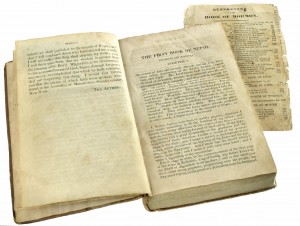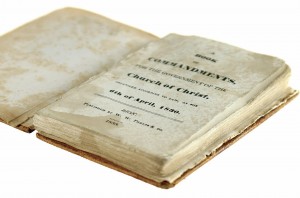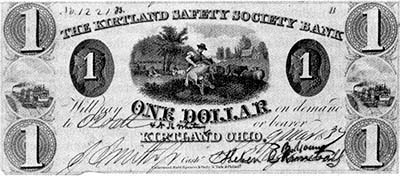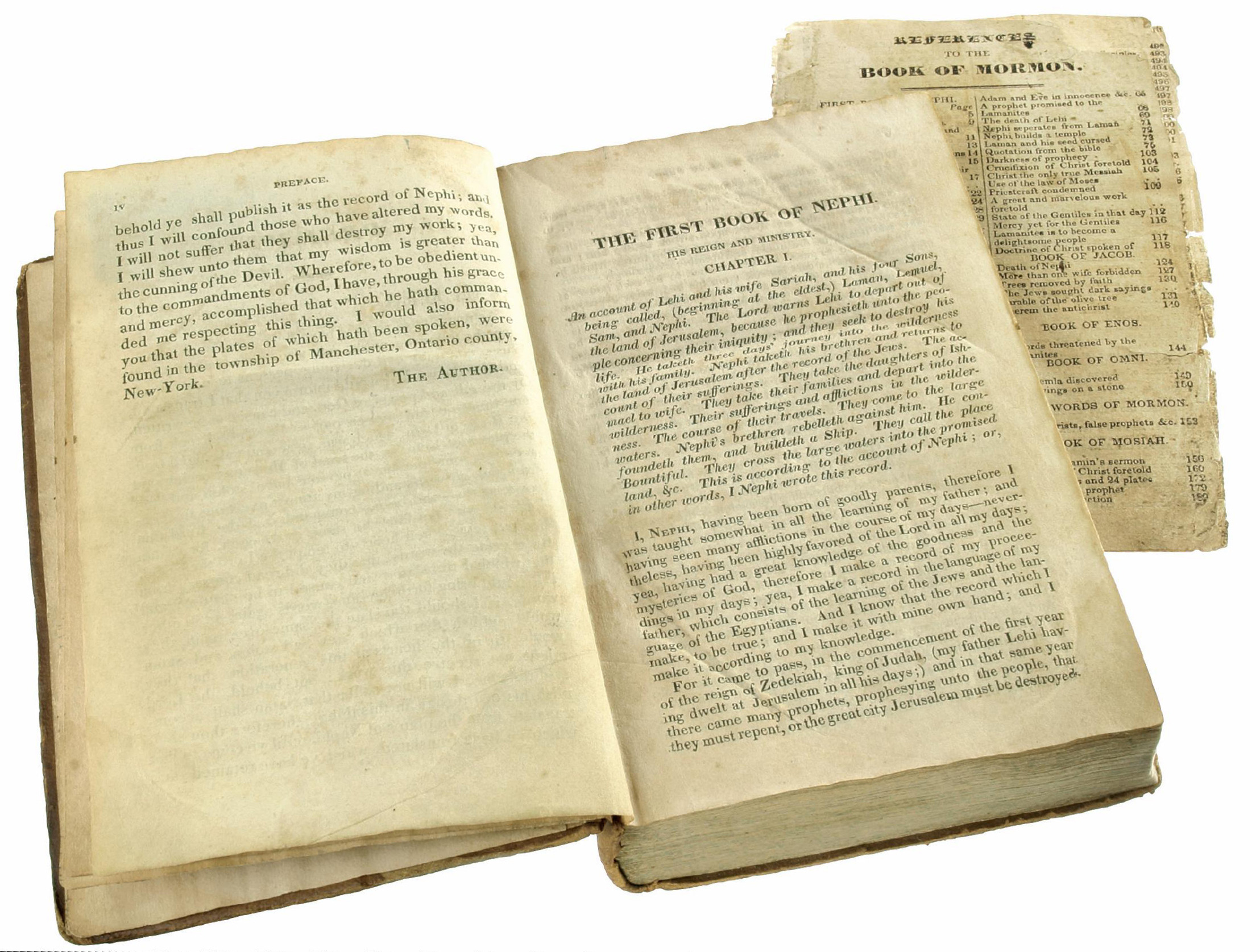During the early days of the history of The Church of Jesus Christ of Latter-day Saints, members experienced and endured unjustified suffering and persecution. On numerous occasions, they were driven from their homes and forced to leave behind many of their precious possessions. Among those things that were left behind, lost, or destroyed were books, coins, notes, and documents which have long since been salvaged as a means of preserving history.
1830 First Edition of the Book of Mormon – How Rare a Possession
 Among the rare artifacts that have been recovered from early Church history is an original 1830 first edition of the Book of Mormon. Although the edition is not considered the rarest LDS publication, it is in fact a treasured commodity to be had by serious collectors as it marks the beginning of the Lord’s true Church in this dispensation. Only five thousand copies of the first Book of Mormon were printed, and each sold for the cost of 75 cents. Today it is estimated that only a few hundred copies remain in any condition, and a majority of those are not complete copies. It is interesting to note that in 1998, Bill Gates, founder of Microsoft, purchased an 1830 first edition copy of the Book of Mormon.
Among the rare artifacts that have been recovered from early Church history is an original 1830 first edition of the Book of Mormon. Although the edition is not considered the rarest LDS publication, it is in fact a treasured commodity to be had by serious collectors as it marks the beginning of the Lord’s true Church in this dispensation. Only five thousand copies of the first Book of Mormon were printed, and each sold for the cost of 75 cents. Today it is estimated that only a few hundred copies remain in any condition, and a majority of those are not complete copies. It is interesting to note that in 1998, Bill Gates, founder of Microsoft, purchased an 1830 first edition copy of the Book of Mormon.
Two back-to-back pages, which became referred to as “References to the Book of Mormon,” were placed inside copies of the first copies of the 1830 edition of the Book of Mormon to be used as a navigation tool – an index – by missionaries as they used the Book of Mormon to teach the gospel. The pages were not attached which made it easy for them to be lost or destroyed. Together with the pages from the 1830 first edition, these have become some of the rarest and most expensive printed pages in the history of The Church of Jesus Christ.
1833 Book of Commandments – First Record of Printed Revelations
In July 1833, the early Church was to publish the first collection of printed revelations in a book titled “Book of Commandments.” The press and the thousands of pages waiting to be folded and cut was located on the upper floor of the home of William W. Phelps. The publication was abruptly disrupted on 20 July 1833 when a mob broke in, chased Phelps’ wife and children out, and destroyed the press. The printed pages were dumped into the street with the intent of the mob to destroy them.
 In an act of courage, 15-year-old Mary Elizabeth Rollins and her 13-year-old sister Caroline grabbed up as many sheets as they could hold and ran. They were discovered and chased by the mob, but were never found. The pages that they were able to salvage were hand cut and bound into 15 incomplete copies of the Book of Commandments with covers made out of leather, goat hair, and even wood. In 2001, a rare complete copy of the Book of Commandments was sold at auction at Christie’s in New York for the hefty price of $391,000 – the most money ever paid for a nineteenth century American book.
In an act of courage, 15-year-old Mary Elizabeth Rollins and her 13-year-old sister Caroline grabbed up as many sheets as they could hold and ran. They were discovered and chased by the mob, but were never found. The pages that they were able to salvage were hand cut and bound into 15 incomplete copies of the Book of Commandments with covers made out of leather, goat hair, and even wood. In 2001, a rare complete copy of the Book of Commandments was sold at auction at Christie’s in New York for the hefty price of $391,000 – the most money ever paid for a nineteenth century American book.
The destruction of the Book of Commandments did not thwart the work of the Lord from progressing, nor His Word from going forth. The Brethren immediately began work on compiling another Book of Commandments. However, after deliberating that the book contained more than just commandments, it was agreed that the new book should be titled “Doctrine and Covenants,” and in an 1835 conference, the Doctrine and Covenants was accepted as scripture.
Kirtland and Early Mormon Currency
 In 1836, the first attempts of producing Mormon currency took place in Kirtland, Ohio when the young growing Church decided to establish a bank. The Ohio legislature denied their charter, and so they created the Kirtland Safety Society Anti-Banking Company. The currency that was distributed, known as Kirtland Safety Society Notes, were signed by Joseph Smith and Sidney Rigdon.
In 1836, the first attempts of producing Mormon currency took place in Kirtland, Ohio when the young growing Church decided to establish a bank. The Ohio legislature denied their charter, and so they created the Kirtland Safety Society Anti-Banking Company. The currency that was distributed, known as Kirtland Safety Society Notes, were signed by Joseph Smith and Sidney Rigdon.
Coins were also made and used as currency. In 1846, while camped in Iowa Territory, Peter Haws created a brass coin which became known as “Do Your Duty” Coin which was used by members of The Church of Jesus Christ throughout Pottawattamie County. According to the LDS Living.com article dated 8 August 2014, “He embossed one side with a beehive and the slogan “Do Your Duty.” On the other side, he embossed hands clasped together with the motto “Union Is Strength.””
In 1848, after the Saints had settled in the Great Salt Lake Valley, President Brigham Young directed the Brethren to establish a mint for the production of gold coins. The production of the coins began in 1849. The LDS Living.com article describes the coins as follows:
Like all 1849 gold Mormon coins, the ten dollar denomination features an open eye and a crown surrounded by the words “Holiness to the Lord.” The reverse side of the coin shows two hands clasped. “Pure Gold” and “Ten Dollars” is written around the hands.
Unfortunately, the life of the gold coins was short-lived because of their rejection in non-Mormon territories due to their substandard weight. Some banks did accept them at a 25 percent discount, but most were melted.
1842 Book of Mormon – Last Edition Published Under Direction of Joseph Smith
The 1842 edition of the Book of Mormon has become the scarcest of all copies of the Book of Mormon as it was the last edition that was published under the direction of the Prophet, Joseph Smith, in Nauvoo, Illinois. Joseph’s father had passed away before the volume was complete, and so it is the only volume that credits him without the usual suffix of “Junior.”
The Legacy of the Early Church
The Saints lived under constant persecution, and were often attacked and forced to flee for their lives to find solace in unexplored territories. Oftentimes they took flight with nothing more than the clothes on their backs, and their children at their side. Many valuable and meaningful journals and documents had to be left behind, and in time were completely lost or destroyed. With such precious losses, a part of their legacy was also lost. Nevertheless, they continued to press forward by faith. We can be thankful that with the discovery of rare artifacts from early Church history, a large part of that legacy can be reclaimed. We can also be thankful that in spite of the opposition, the work of the Lord continues to roll forth. The Prophet Joseph Smith declared:
The Standard of Truth has been erected; no unhallowed hand can stop the work from progressing; persecutions may rage, mobs may combine, armies may assemble, calumny may defame, but the truth of God will go forth boldly, nobly, and independent, till it has penetrated every continent, visited every clime, swept every country, and sounded in every ear, till the purposes of God shall be accomplished, and the Great Jehovah shall say the work is done.
About Keith L. Brown
Keith L. Brown is a convert to The Church of Jesus Christ of Latter-day Saints, having been born and raised Baptist. He was studying to be a Baptist minister at the time of his conversion to the LDS faith. He was baptized on 10 March 1998 in Reykjavik, Iceland while serving on active duty in the United States Navy in Keflavic, Iceland. He currently serves as the First Assistant to the High Priest Group for the Annapolis, Maryland Ward. He is a 30-year honorably retired United States Navy Veteran.


 Watch a video about the restoration of the gospel on lds.org
Watch a video about the restoration of the gospel on lds.org